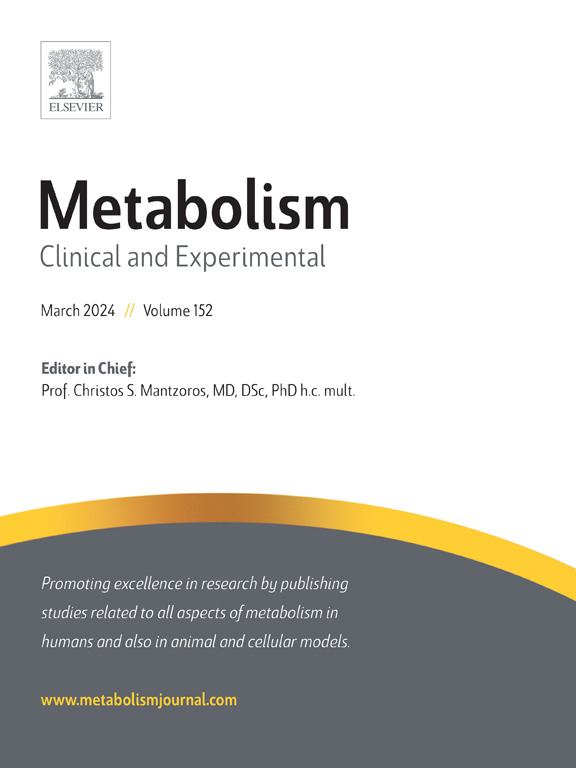肝脏miR-93通过抑制SIRT1促进代谢功能障碍相关脂肪变性肝病的发病机制
IF 10.8
1区 医学
Q1 ENDOCRINOLOGY & METABOLISM
引用次数: 0
摘要
背景和目的代谢功能障碍相关脂肪变性肝病(MASLD)的分子机制仍不清楚;然而,新出现的证据表明,microRNAs (miRNAs)在调节与MASLD相关的靶基因的转录调控中起着关键作用。本研究旨在阐明miR-93在脂质代谢和MASLD进展中的作用。方法综合分析MASLD患者和饮食性肥胖小鼠肝脏组织中miRNA的表达谱。miR-93敲除(KO)小鼠喂食高脂肪-高果糖(HFHFr)饮食,以评估miR-93缺乏对MASLD的影响。转录组分析旨在阐明miR-93在MASLD中的分子机制和作用。此外,我们采用了高通量筛选系统来鉴定能够调节miR-93表达的药物。结果smir -93在MASLD患者和饮食性肥胖小鼠的肝脏中显著上调。miR-93 KO小鼠表现出肝脏脂肪变性减少。具体来说,miR-93缺乏上调了参与脂肪酸氧化的基因,下调了与胆固醇生物合成相关的基因。Sirtuin 1 (SIRT1)被确定为miR-93的直接靶点,miR-93 KO增强SIRT1表达并激活LKB1-AMPK信号通路。烟酸治疗下调miR-93,通过增强SIRT1活性改善肝脂肪变性。结论这些发现提示miR-93是一种新的MASLD治疗靶点。该研究证明烟酸在调节miR-93/SIRT1轴中的治疗潜力,为MASLD提供了一种新的潜在治疗方法,MASLD是一种目前治疗方案有限的疾病。本文章由计算机程序翻译,如有差异,请以英文原文为准。

Hepatic miR-93 promotes the pathogenesis of metabolic dysfunction-associated steatotic liver disease by suppressing SIRT1
Background and aims
The molecular mechanisms underlying metabolic dysfunction-associated steatotic liver disease (MASLD) remain largely unclear; however, emerging evidence suggests that microRNAs (miRNAs) play a critical role in modulating transcriptional regulation of target genes involved in MASLD. This study aims to elucidate the role of miR-93 in lipid metabolism and MASLD progression.
Methods
We comprehensively analyzed miRNA expression profiles in liver tissues from patients with MASLD and diet-induced obese mice. miR-93 knockout (KO) mice were fed a high-fat–high-fructose (HFHFr) diet to assess the impact of miR-93 deficiency on MASLD. Transcriptome analysis was performed to elucidate the molecular mechanisms and role of miR-93 in MASLD. Additionally, we employed a high-throughput screening system to identify drugs capable of modulating miR-93 expression.
Results
miR-93 was significantly upregulated in the livers of patients with MASLD and diet-induced obese mice. miR-93 KO mice exhibited reduced hepatic steatosis. Specifically, miR-93 deficiency upregulated genes involved in fatty acid oxidation and downregulated genes associated with cholesterol biosynthesis. Sirtuin 1 (SIRT1) was identified as a direct target of miR-93, and miR-93 KO enhanced SIRT1 expression and activated the LKB1-AMPK signaling pathway. Niacin treatment downregulated miR-93, ameliorating hepatic steatosis by enhancing SIRT1 activity.
Conclusions
These findings implicate miR-93 as a novel therapeutic target for MASLD. The study demonstrates the therapeutic potential of niacin in modulating the miR-93/SIRT1 axis, providing a new potential treatment for MASLD, a disease with limited current treatment options.
求助全文
通过发布文献求助,成功后即可免费获取论文全文。
去求助
来源期刊

Metabolism: clinical and experimental
医学-内分泌学与代谢
CiteScore
18.90
自引率
3.10%
发文量
310
审稿时长
16 days
期刊介绍:
Metabolism upholds research excellence by disseminating high-quality original research, reviews, editorials, and commentaries covering all facets of human metabolism.
Consideration for publication in Metabolism extends to studies in humans, animal, and cellular models, with a particular emphasis on work demonstrating strong translational potential.
The journal addresses a range of topics, including:
- Energy Expenditure and Obesity
- Metabolic Syndrome, Prediabetes, and Diabetes
- Nutrition, Exercise, and the Environment
- Genetics and Genomics, Proteomics, and Metabolomics
- Carbohydrate, Lipid, and Protein Metabolism
- Endocrinology and Hypertension
- Mineral and Bone Metabolism
- Cardiovascular Diseases and Malignancies
- Inflammation in metabolism and immunometabolism
 求助内容:
求助内容: 应助结果提醒方式:
应助结果提醒方式:


